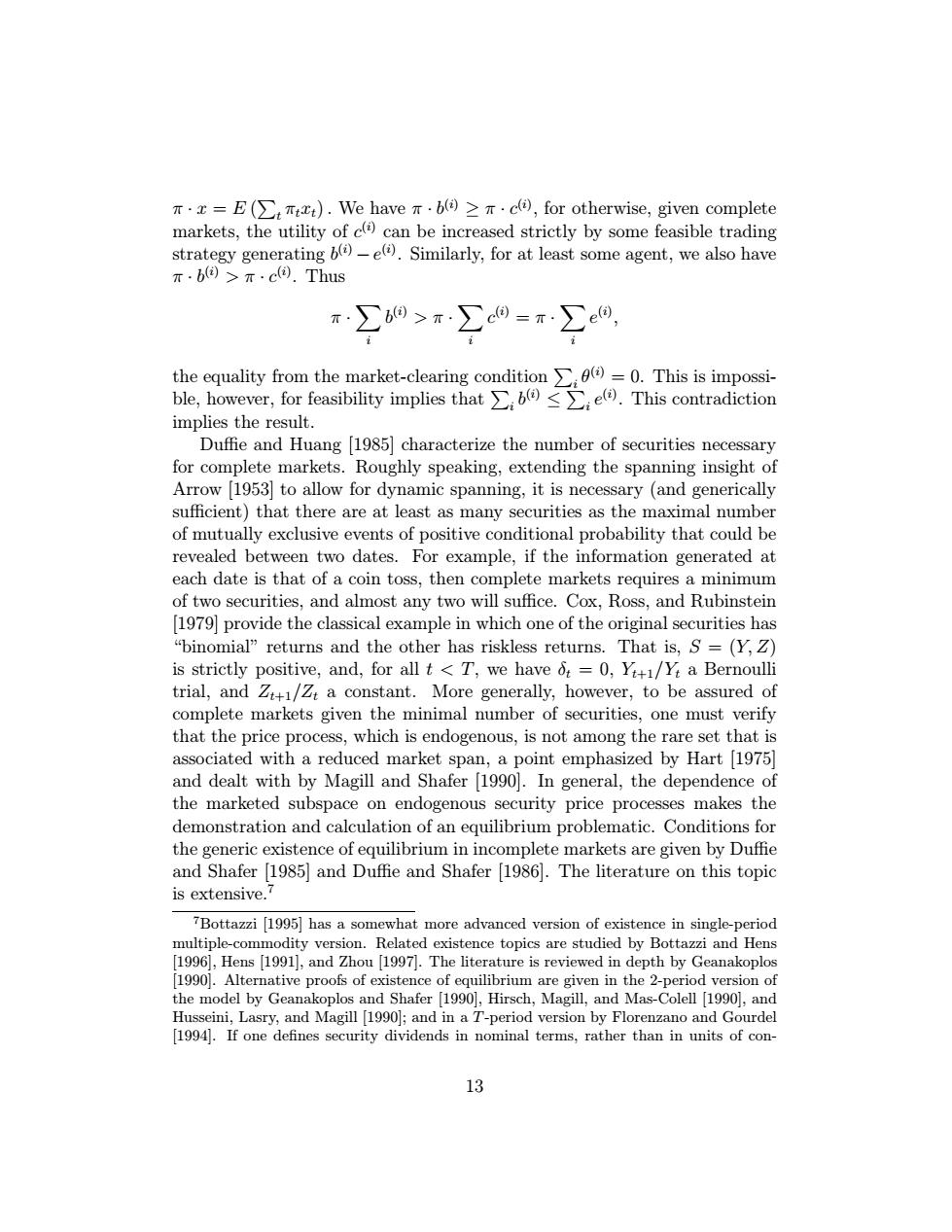正在加载图片...

T·x=E(∑TTt).We have·b≥T·c,for otherwise,given complete markets,the utility of c()can be increased strictly by some feasible trading strategy generating ()-e().Similarly,for at least some agent,we also have T.b@>T·c.Thus m∑b9>T∑c=T∑e, the equality from the market-clearing condition>()=0.This is impossi- ble,however,for feasibility implies that∑:bo≤∑:e.This contradiction implies the result Duffie and Huang [1985]characterize the number of securities necessary for complete markets.Roughly speaking,extending the spanning insight of Arrow [1953]to allow for dynamic spanning,it is necessary (and generically sufficient)that there are at least as many securities as the maximal number of mutually exclusive events of positive conditional probability that could be revealed between two dates.For example,if the information generated at each date is that of a coin toss,then complete markets requires a minimum of two securities,and almost any two will suffice.Cox,Ross,and Rubinstein [1979]provide the classical example in which one of the original securities has "binomial"returns and the other has riskless returns.That is,S=(Y,Z) is strictly positive,and,for all tT,we have 6=0,Yi+1/Y:a Bernoulli trial,and Z/Z a constant.More generally,however,to be assured of complete markets given the minimal number of securities,one must verify that the price process,which is endogenous,is not among the rare set that is associated with a reduced market span,a point emphasized by Hart [1975] and dealt with by Magill and Shafer [1990.In general,the dependence of the marketed subspace on endogenous security price processes makes the demonstration and calculation of an equilibrium problematic.Conditions for the generic existence of equilibrium in incomplete markets are given by Duffie and Shafer [1985]and Duffie and Shafer [1986].The literature on this topic is extensive. 7Bottazzi [1995]has a somewhat more advanced version of existence in single-period multiple-commodity version.Related existence topics are studied by Bottazzi and Hens [1996],Hens [1991],and Zhou [1997].The literature is reviewed in depth by Geanakoplos [1990].Alternative proofs of existence of equilibrium are given in the 2-period version of the model by Geanakoplos and Shafer [1990],Hirsch,Magill,and Mas-Colell [1990],and Husseini,Lasry,and Magill [1990];and in a T-period version by Florenzano and Gourdel [1994].If one defines security dividends in nominal terms,rather than in units of con- 13π · x = E ( P t πtxt). We have π · b(i) ≥ π · c(i) , for otherwise, given complete markets, the utility of c(i) can be increased strictly by some feasible trading strategy generating b(i) −e(i) . Similarly, for at least some agent, we also have π · b(i) > π · c(i) . Thus π · X i b(i) > π · X i c(i) = π · X i e(i) , the equality from the market-clearing condition P i θ(i) = 0. This is impossible, however, for feasibility implies that P i b(i) ≤ P i e(i) . This contradiction implies the result. Duffie and Huang [1985] characterize the number of securities necessary for complete markets. Roughly speaking, extending the spanning insight of Arrow [1953] to allow for dynamic spanning, it is necessary (and generically sufficient) that there are at least as many securities as the maximal number of mutually exclusive events of positive conditional probability that could be revealed between two dates. For example, if the information generated at each date is that of a coin toss, then complete markets requires a minimum of two securities, and almost any two will suffice. Cox, Ross, and Rubinstein [1979] provide the classical example in which one of the original securities has “binomial” returns and the other has riskless returns. That is, S = (Y,Z) is strictly positive, and, for all t<T, we have δt = 0, Yt+1/Yt a Bernoulli trial, and Zt+1/Zt a constant. More generally, however, to be assured of complete markets given the minimal number of securities, one must verify that the price process, which is endogenous, is not among the rare set that is associated with a reduced market span, a point emphasized by Hart [1975] and dealt with by Magill and Shafer [1990]. In general, the dependence of the marketed subspace on endogenous security price processes makes the demonstration and calculation of an equilibrium problematic. Conditions for the generic existence of equilibrium in incomplete markets are given by Duffie and Shafer [1985] and Duffie and Shafer [1986]. The literature on this topic is extensive.7 7Bottazzi [1995] has a somewhat more advanced version of existence in single-period multiple-commodity version. Related existence topics are studied by Bottazzi and Hens [1996], Hens [1991], and Zhou [1997]. The literature is reviewed in depth by Geanakoplos [1990]. Alternative proofs of existence of equilibrium are given in the 2-period version of the model by Geanakoplos and Shafer [1990], Hirsch, Magill, and Mas-Colell [1990], and Husseini, Lasry, and Magill [1990]; and in a T -period version by Florenzano and Gourdel [1994]. If one defines security dividends in nominal terms, rather than in units of con- 13